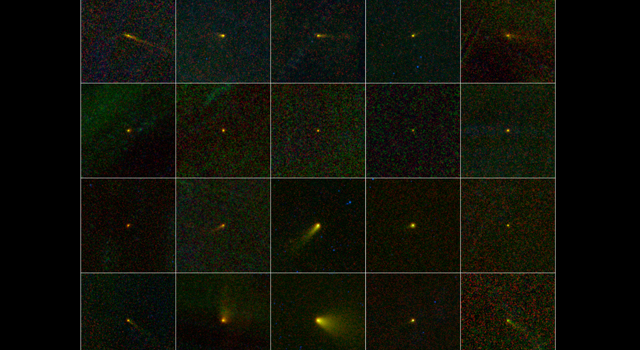We're open daily this holiday! View holiday hours
Science News
Potentially Hazardous Asteroid
May 23, 2012
by Alyssa Keimach

The Wide-field Infrared Survey Explorer (WISE) spacecraft was originally sent on a mission to catalogue millions of super-luminous galaxies and stellar nurseries. But astronomers discovered even more—WISE’s advanced infrared technology also uncovered information about asteroids orbiting perhaps a little too close to Earth.
While an optical telescope will show viewers bright dots in the sky, an infrared telescope, such as WISE, will see beyond the apparent brightness to identify the size of the object, independent of its reflective properties.
Within the WISE mission is another mission called NEOWISE. NEOWISE searches for Near-Earth Objects, or NEOs, to learn more about Potentially Hazardous Asteroids (PHAs).
PHAs are a subclass of near-earth objects: their orbits lie within eight million kilometers (five million miles) of Earth’s orbit, and they are massive enough to survive passage through Earth’s atmosphere and cause significant damage.
Past approximations of PHA populations were fairly rough estimates. NEOWISE returned a more precise evaluation of PHAs. The project sampled 107 PHAs to make predictions about the population as a whole: estimates range from 3,200 and 6,200 PHAs with diameters larger than 330 feet (about 100 meters). So far, scientists have discovered an estimated 20 to 30 percent of these objects.
Not to worry, these asteroids are not on a mission to destroy Earth. They are classified as PHAs to identify that their orbits should be calculated more carefully.
“The NEOWISE analysis shows us we’ve made a good start at finding those objects that truly represent an impact hazard to Earth,” says Lindley Johnson, of NASA’s Near-Earth Object Observation Program. “But we’ve many more to find, and it will take a concerted effort during the next couple of decades to find all of them that could do serious damage or be a mission destination in the future.”
(If you’re in Europe and want to help hunt for these potentially dangerous neighbors, read this Universe Today article to learn about the European Space Agency’s new crowdsourcing project.)
And perhaps some of these potentially hazardous can become potentially resourceful asteroids. The recently-announced asteroid mining industry has big plans for asteroids with low-inclination orbits. Asteroids that revolve around the Sun in a plane similar to Earth’s orbit are relatively accessible to spacecraft and therefore have greater potential for asteroid mining.
“NASA’s NEOWISE project, which wasn’t originally planned as part of WISE, has turned out to be a huge bonus,” says Amy Mainzer, NEOWISE Principal Investigator at NASA/JPL. “Everything we can learn about these objects helps us understand their origins and fate. Our team was surprised to find the overabundance of low-inclination PHAs. Because they will tend to make more close approaches to Earth, these targets can provide the best opportunities for the next generation of human and robotic exploration.”
Further explanation of orbiting objects can be seen here.
Alyssa Keimach is an astronomy and astrophysics student at the University of Michigan and volunteers for the Morrison Planetarium.
Image: NASA/JPL-Caltech/UCLA